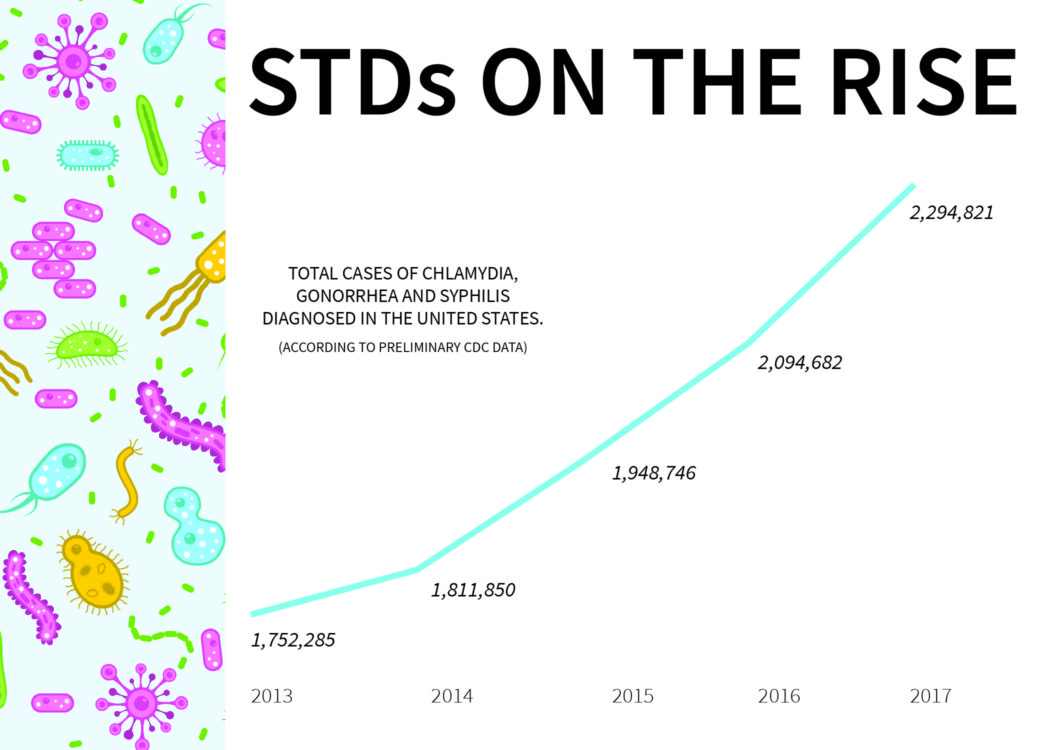STD Rates in the US Reach Record High the CDC reports
Rates for gonorrhea, chlamydia and syphilis have rose for the fourth consecutive year in the United States, announced the Center for Disease Control and Prevention at the 2018 STD Prevention Conference.
2.3 million cases of sexually transmitted diseases were diagnosed in 2017, making it the highest number ever reported. More than 2000,000 cases above what was reported for 2016.
The executive director of the National Coalition of STD directors, David Harvey, urged the Trump administration to declare a public health crisis over a month ago. The administration has not responded, though during the 2016 elections the President went on record saying that STDs are his “personal Vietnam” and that vaginas are “potential landmines.”
At USU, experts are weighing in urging both male and female students to take precautions when entering into any type of sexual activity.
“There is a big list of different things that you can do,” said Dr. John Malouf of Utah State Student Health Services. “Monogamy is going to be high on my list because the larger number of partners that you have, the higher you are at risk and the more partners that you are exposed to.”
He continued.
“Condoms are a minimum that everyone should be doing. Condoms, female condoms and dental dams whether you are having anal sex, vaginal sex, or oral sex. You can get STDs from any of those and I’ve had patients who have STDs on their skin or in their eyes and it can be prevented by safer sex.”
Malouf said the number of STDs in the CDC’s report is only the number of STDs that are required to be reported and that have symptoms as sexually transmitted infections typically do not have any symptoms.
Emmalee Fishburn, the prevention specialist in the Affirmative Action and Equal Opportunity Office at USU, said her role on campus focuses on coordinating sexual violence prevention including the components of healthy and unhealthy relationships. Fishburn was also a middle and high school sex education teacher.
“Adopting safe sex practices prevents you and your sexual partner(s) from having to worry about potential, sometimes negative, outcomes from engaging in sexual activity, which makes it easier to enjoy sex,” Fishburn said.
She said safe sex should be practiced for all forms of sexual activity, including fingering and the use of sex toys.
Neglecting to alert a sexual partner to the possibility of having an sexually transmitted infection or an STD is not a consensual form of safe sex.
“Most people who have an STI or STD actually don’t have any symptoms, which means they don’t know they’re infected and are more likely to pass the infection to a sexual partner. Getting tested (regularly) is the only way to know for sure whether or not you have and STI or an STD,” Fishburn said.
According to CNN, who reported on the CDC’s findings, the CDC’s budget has declined 40 percent in the past 15 years and state and local budget cuts of STD programs may be an influencer in the rise of STD rates.
Students at Utah State are not immune to STDs and are “obviously entering into sexual situations,” Malouf said, admitting that he has no way of guaranteeing that his patients will listen to him.
“I think it’s the technology,” said USU student Ceasar Anilito. “At the touch of a button I can find 50 people willing to hook up and at least one of them in that moment is likely to have sex; usually with no more than a few words and pictures shared between us.”
Testing for STDs isn’t free at the Student Health and Wellness Center but can be billed to a student’s insurance. Appointments at the center are free and are included in the cost of tuition. The Center for Pregnancy Choices and Planned Parenthood are local resources for confidential screenings.
—erickwood97@gmail.com
@GrahamWoodMedia

